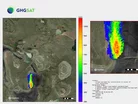Methane emissions from Kazakhstan mine 'equal to 2.6m cars'

Methane emissions released by an open cast mine in Kazakhstan mine totalled 54,000 kg/hr in the first two months of this year, according to satellite observations by GHGSat, an environmental monitoring company.
The emissions were equivalent to the CO2 released by around 2.6m cars driving for a year, if sustained.
The findings challenge conventional orthodoxy that emissions from surface mines are rare, low and ‘not known to be significant’.
Methane is a greenhouse gas around 84 times more potent than CO2 over 20 years. It is also an unavoidable bi-product of coal mining, with pockets of gas released as seams are opened. In 2019 the US Environmental Protection Agency (EPA) estimated that 11% of all man-made methane emissions came from coal mining.
GHGSat began its study of open cast mines in June 2021, investigating targets identified from public data by regular collaborator SRON, the Netherlands Institute for Space Research. Its high-resolution instruments image down to 25m on the ground, making it possible to attribute leaks and measure emission rates.
Last October, GHGSat observed emissions of 27,500kg/hr coming from mines in the Ekibastuz region of Kazakhstan. Shortly afterwards, their satellites recorded CH4 being released at China’s Hei Dai Gou facility, the world’s third biggest mine, covering an area of 42sqkm.
On January 1, an emission of 45,289kg/hr was detected from Kazakhstan’s, largest mine, Bogatyr. Further passes, on January 27 and February 4 recorded additional releases measuring 54,314, kg/hr, 23,081 kg/hr and 37,455 kg/hr at the same site.
A satellite pass over the Krasnobrodsky mine, in the Kemerovo Oblast region of Russia, on February 5, revealed that it was generating similarly large quantities of methane - 44,669kg/hr - despite producing far less coal (5.9m tonnes p/a, compared to Bogatyr’s 32m tonnes).
GHGSat study shows methane emissions from surface mines can be observed from space
It was believed that methane emissions from surface mines could not be accurately measured by satellite, as the gas would disperse over a wide area. It was also thought unlikely that open cast mines could be major sources of greenhouse gas, despite 40% of all mines – including the 10 biggest - being of this type.
The latest official guidance on coal mine methane, published by the United Nations Economic Commission for Europe (December 2021), states: “Although there are some examples of surface mines with significant gas resources, large-scale CH4 emissions at individual mines are rare. Collectively, surface mine methane emissions appear to be much lower and more diffuse compared to emissions from underground mines. On a global scale they are not known to be significant in terms of CH4 emissions."
GHGSat’s study, although in its infancy, shows that it is possible to observe methane emissions from surface mines from space, and suggests that they may be a more important source of greenhouse gas pollution than currently thought.
Stephane Germain, founder and CEO of GHGSat said the UN report flags the possibility that satellites will ‘help reduce uncertainty on the scale of emissions from surface mines.’
"We are delivering on that promise, today. We know that reducing the amount of methane released by man-made processes is one of the most effective climate actions we can take," he said.
"Coalmines are significant sources of methane but there has been little serious effort to independently monitor them. We have now proven that the technology exists to do this, even for surface mines. GHGSat will be expanding its investigations into coal mine emissions in 2022.”



